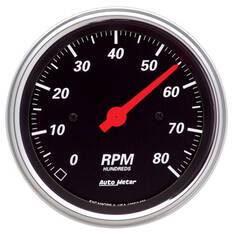How a Tachometer Assists Display Engine Health and Performance
How a Tachometer Assists Display Engine Health and Performance
Blog Article
The Value of a Tachometer in Keeping An Eye On Engine Rate and Performance in Automotive Applications
In the world of automobile design, the tachometer stands as a pivotal tool in the motorist's toolbox, offering a straight home window into the inner workings of a lorry's engine. Past its feature as a plain scale of transformations per minute (RPM), the tachometer functions as a crucial device for fanatics and experts alike, using real-time understandings into engine efficiency and health. Comprehending the relevance of this device goes past surface-level observations, delving into the complex connection between engine speed, power outcome, and total driving experience. As we explore the multifaceted role of the tachometer in vehicle applications, a deeper gratitude for its effect on vehicle characteristics and efficiency begins to emerge.
Relevance of Checking Engine RPM
Checking engine RPM, or revolutions per min, is an important aspect of automobile upkeep and performance analysis. Engine RPM directly associates with the rate at which the engine's crankshaft turns, indicating how swiftly the engine is running.
Moreover, checking engine RPM is essential for efficiency examination in racing and high-performance automobiles. Preserving ideal RPM degrees is important for accomplishing peak power output and velocity. Racers typically use tachometers to guarantee they are operating within the ideal RPM variety for optimum performance. In recap, checking engine RPM is not only important for detecting concerns but additionally for enhancing engine efficiency in various vehicle applications.

Advantages of Real-Time Information
In vehicle applications, real-time data plays a vital role in offering instant understandings into the performance and condition of the car. By constantly keeping track of different specifications such as engine rate, temperature level, fuel consumption, and much more, real-time data supplies various benefits that add to enhanced effectiveness and safety when driving.
In addition, real-time information facilitates efficiency optimization by supplying instant comments on driving practices and engine effectiveness. Motorists can readjust their actions in real-time based on this details to achieve better fuel economic situation and extend the lifespan of their vehicle.

Furthermore, real-time data plays an essential role in modern automobile diagnostics, making it possible for technicians to promptly detect and resolve breakdowns. This leads to lowered downtime, lower upkeep expenses, and ultimately, boosted total car integrity and durability (tachometer). By using the power of real-time data, auto stakeholders can make enlightened decisions that favorably impact both the efficiency and durability of the car
Influence On Equipment Shifts
Effective equipment shifts in automobile applications substantially influence total performance and driving experience. The tachometer plays a crucial duty in optimizing gear changes by supplying real-time engine speed data to the vehicle driver. When coming close to the redline on the tachometer, it signifies the vehicle driver to upshift to stop over-revving the engine and causing possible damage. On the other hand, downshifting at the best moment can assist keep the engine in its power band, guaranteeing receptive velocity when required.
Additionally, the tachometer aids in achieving smoother equipment shifts, particularly in hands-on transmissions. By keeping track of engine rate, motorists can perform gear shifts at the optimal RPM variety, lowering jerking activities and decreasing wear on the transmission parts. This accuracy in gear adjustments not only improves driving comfort however additionally adds to fuel effectiveness.
Enhancing Fuel Efficiency
Given the critical duty the tachometer plays in maximizing gear changes for performance and engine wellness, it straight adds to optimizing fuel efficiency in vehicle applications. By giving real-time feedback on engine rate, the tachometer helps motorists in preserving the most efficient best site RPM range for gas economy. When chauffeurs regularly keep track of the tachometer and change their motoring habits accordingly, they can stay clear of unnecessary fuel usage caused by over-revving or lugging the engine.
Additionally, the tachometer assists drivers determine one of the most fuel-efficient gear to be in at any provided moment, protecting against the engine from functioning tougher than essential. This is especially critical during acceleration and cruising, where remaining in the best gear can significantly affect fuel efficiency. In addition, the tachometer can signal motorists to possible mechanical issues that might be negatively impacting fuel economy, such as a slipping clutch or a blocked air filter. To conclude, the tachometer serves as a valuable device in boosting fuel effectiveness by advertising optimum driving behaviors and determining locations for improvement in the car's efficiency.

Maximizing Engine Longevity
The tachometer's function in monitoring engine rate and efficiency contributes in making sure the durability of automobile engines. By using the tachometer efficiently, drivers can optimize engine longevity with conscious RPM monitoring. Consistently revving an engine expensive can bring about too much wear and tear on vital parts, such as the pistons, valves, and bearings. In time, this can lead to reduced engine efficiency and potential breakdowns. Checking the tachometer enables drivers to stay within the advised RPM array for their lorry, protecting against unnecessary strain on the engine and expanding its lifespan.

Final Thought
In conclusion, the tachometer plays a vital role in keeping track of engine speed and performance in automobile applications. By giving real-time data on RPM, it permits efficient equipment shifts, boosted gas effectiveness, and made the most of engine longevity. This device is important for preserving optimum engine efficiency and making sure the total performance of great post to read an automobile.
Report this page